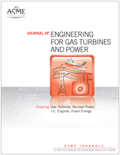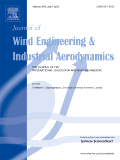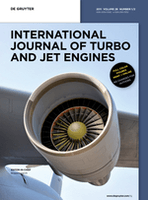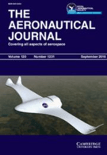
AIAA JOURNAL
Scope & Guideline
Exploring the Frontiers of Flight and Space Technology
Introduction
Aims and Scopes
- Aerodynamics and Fluid Dynamics:
The journal extensively covers the study of airflow, including topics such as turbulence modeling, boundary layer interactions, and aerodynamic optimization methods for various aerospace configurations. - Aeroelasticity and Structural Dynamics:
Research on the interaction between aerodynamic forces and structural responses is a key area, including flutter analysis, dynamic stability, and the optimization of flexible structures under aerodynamic loads. - Propulsion and Combustion:
The journal addresses advancements in propulsion technologies, including the analysis of scramjet combustors, detonation waves, and combustion dynamics in various environments. - Materials and Structural Integrity:
There is a consistent focus on innovative materials, such as composites, and their performance under different loading conditions, including fatigue, thermal effects, and damage tolerance. - Data-Driven and Computational Methods:
The journal includes significant research on computational fluid dynamics (CFD), machine learning applications, and reduced-order modeling techniques to enhance simulation accuracy and efficiency in aerospace applications. - Hypersonic and Supersonic Flow Studies:
Research related to hypersonic and supersonic flows, including shock wave interactions, boundary layer transition, and noise predictions, is a prominent area of focus. - Aeroacoustics:
The journal explores noise generation and control mechanisms in aerospace applications, particularly in relation to rotorcraft, jets, and other aerodynamic surfaces.
Trending and Emerging
- Machine Learning and AI in Aerospace:
There is a growing trend toward the application of machine learning and artificial intelligence in various aerospace domains, including design optimization, predictive maintenance, and real-time simulation. - Advanced Material Technologies:
Research on advanced materials, such as functionally graded materials and composites with enhanced properties, is trending, driven by the need for lightweight and durable structures in aerospace applications. - Hypersonic Vehicle Research:
The focus on hypersonic vehicle dynamics, including thermal protection systems and hypersonic flow interactions, has gained momentum due to increased interest in hypersonic travel and defense applications. - Data-Driven Aerodynamic Modeling:
The use of data-driven approaches for aerodynamic modeling, including surrogate models and reduced-order methods, is emerging as a critical area of research to enhance simulation capabilities. - Sustainability in Aerospace Engineering:
Research addressing sustainability, including eco-friendly propulsion systems and materials recycling, is increasingly relevant as the aerospace industry seeks to reduce its environmental impact. - Plasma Actuation and Flow Control:
The application of plasma actuation for flow control and drag reduction has become a prominent topic, reflecting advancements in non-conventional methods for enhancing aerodynamic performance.
Declining or Waning
- Classical Aerodynamics:
Traditional studies in classical aerodynamics, such as basic lift and drag calculations, have seen a decline as more complex computational methods and data-driven approaches gain traction. - Static Structural Analysis:
Research focused solely on static structural analysis without considering dynamic interactions has become less common, as the field increasingly emphasizes dynamic and aeroelastic effects. - Conventional Turbulence Models:
The reliance on conventional turbulence modeling approaches without integration of advanced machine learning techniques or hybrid methods is waning as the field moves toward more innovative and accurate modeling strategies. - Fixed-Wing Aircraft Optimization:
Research centered solely on fixed-wing aircraft optimization without considering hybrid or advanced vehicle designs has decreased in favor of broader studies incorporating diverse vehicle configurations.
Similar Journals

Advances in Aerodynamics
Transforming Theoretical Insights into Real-World Applications.Advances in Aerodynamics is a premier scholarly journal published by SPRINGERNATURE, dedicated to the innovative fields of Aerospace Engineering, Civil and Structural Engineering, Mechanical Engineering, and various aspects of Modeling and Simulation. Since its inception in 2019, this open-access journal has rapidly gained recognition, achieving a commendable Q1 ranking in several engineering categories as of 2023. With its compelling focus on pioneering research and advancements in aerodynamics, it serves as an essential platform for original research articles, reviews, and technical notes that address both theoretical frameworks and real-world applications in sustainable engineering practices. With an impact factor fostering its prominence and visibility in the academic community, the journal provides accessible content that fosters knowledge dissemination among researchers, industry professionals, and students alike. Situated in Singapore and with a commitment to rigorously peer-reviewed research, Advances in Aerodynamics is positioned to play a pivotal role in shaping the future of aerodynamics and its applications across various engineering disciplines.

PROCEEDINGS OF THE INSTITUTION OF MECHANICAL ENGINEERS PART G-JOURNAL OF AEROSPACE ENGINEERING
Fostering Collaboration in Aerospace ResearchPROCEEDINGS OF THE INSTITUTION OF MECHANICAL ENGINEERS PART G-JOURNAL OF AEROSPACE ENGINEERING, published by SAGE PUBLICATIONS LTD, stands as a pivotal resource for those immersed in the disciplines of aerospace and mechanical engineering. With an ISSN of 0954-4100 and E-ISSN of 2041-3025, this journal not only contributes to the academic community but also reflects a robust commitment to advancing knowledge within these fields. Operating from the United Kingdom, it has garnered a respectable reputation, evidenced by its category quartiles—ranking Q3 in both Aerospace Engineering and Mechanical Engineering as of 2023. Established in 1989, the journal has evolved substantially over the years, serving as a platform for groundbreaking research and innovative methodologies. Researchers, professionals, and students alike will find a wealth of insights that foster collaboration and advance the frontiers of engineering. Although currently not available as an Open Access publication, the journal remains a critical reference point for those looking to deepen their understanding and contribute to ongoing developments in aerospace technology.

Advances in Aircraft and Spacecraft Science
Connecting Scholars to Shape the Future of AerospaceAdvances in Aircraft and Spacecraft Science is a distinguished journal published by TECHNO-PRESS, focusing on the rapidly evolving fields of aerospace engineering and fluid dynamics. With an ISSN of 2287-528X and an E-ISSN of 2287-5271, this journal is an invaluable resource for researchers, professionals, and students dedicated to advancing knowledge in aircraft and spacecraft technologies. Established in 2014, the journal is committed to disseminating high-quality research findings and innovative methodologies, ensuring that cutting-edge studies can be accessed globally. Despite its current position in the Q4 category for both aerospace engineering and fluid flow transfer processes, it continues to carve a niche in the academic landscape, with Scopus rankings highlighting its contribution to these fields. Operating from South Korea, Advances in Aircraft and Spacecraft Science aims to inspire collaboration and knowledge-sharing among scholars, fostering advancements that drive the aerospace industry forward.

JOURNAL OF ENGINEERING FOR GAS TURBINES AND POWER-TRANSACTIONS OF THE ASME
Fueling Ideas for Sustainable Power SolutionsJournal of Engineering for Gas Turbines and Power - Transactions of the ASME, published by the esteemed American Society of Mechanical Engineers (ASME), is a leading interdisciplinary journal dedicated to advancing the fields of energy engineering, aerospace, nuclear energy, and mechanical engineering. With an impressive history dating back to 1960 and continuing its contributions through 2024, this journal boasts a Q2 ranking in multiple engineering categories, reflecting its strong impact on both academia and industry. Although not an open-access journal, it provides invaluable insights and research findings that cater to the needs of professionals, researchers, and students alike. The journal's ISSN is 0742-4795 with an E-ISSN of 1528-8919, ensuring widespread visibility in the global academic community. Indexed in Scopus, it ranks notably within its fields—21st in Nuclear Energy and Engineering and 51st in Aerospace Engineering—underscoring its relevance and contribution to critical technological advancements. Researchers in this domain will find the journal a vital resource for innovative studies, practical applications, and the latest developments related to gas turbines and power generation.

PROGRESS IN AEROSPACE SCIENCES
Pioneering breakthroughs in aerospace sciences since 1961.PROGRESS IN AEROSPACE SCIENCES is a prestigious journal published by PERGAMON-ELSEVIER SCIENCE LTD, recognized as a leading platform in the field of aerospace engineering, mechanical engineering, and mechanics of materials. With an impressive history dating back to 1961, the journal covers a wide spectrum of topics pivotal to advancing aerospace technology and innovation. Its recent ranking as Q1 in multiple engineering categories underscores its significance, ranking #1 in Aerospace Engineering and placing within the top 20 percentile in both Mechanical Engineering and Mechanics of Materials, according to Scopus assessments. Researchers, professionals, and students looking to engage with high-impact research will find PROGRESS IN AEROSPACE SCIENCES an invaluable resource, offering insights into cutting-edge developments and methodologies. Although it does not operate under an open-access model, the journal upholds rigorous peer-review standards, ensuring that the published content meets the highest academic integrity. Situated in the United Kingdom, it plays a critical role in fostering international collaboration and knowledge-sharing in the aerospace sector.

Thermophysics and Aeromechanics
Igniting Innovation in Thermophysics and AeromechanicsThermophysics and Aeromechanics, published by PLEIADES PUBLISHING INC, is an esteemed journal dedicated to advancing the fields of aerospace engineering, energy engineering, modeling and simulation, as well as nuclear and high energy physics. With an ISSN of 0869-8643 and E-ISSN 1531-8699, this journal serves as a vital platform for researchers and professionals working at the intersection of thermophysics and aeromechanics, delivering cutting-edge research, reviews, and case studies. Despite its current position in Quartile Q4 across multiple categories, including aerospace and energy engineering, it provides a unique opportunity for emerging ideas in these domains to gain visibility and impact. The journal's convergence of diverse scientific disciplines is critical for fostering innovation and technological advancements, making it an essential resource for students, practitioners, and academics alike. In this era of rapid scientific development, Thermophysics and Aeromechanics plays a pivotal role in disseminating knowledge and facilitating interdisciplinary collaboration among a global audience.

Journal of the Global Power and Propulsion Society
Fostering Global Dialogue in Aerospace AdvancementsJournal of the Global Power and Propulsion Society, published by GLOBAL POWER PROPULSION SOC, is a premier open-access journal established in 2017, dedicated to the dissemination of innovative research and advancements in the fields of aerospace engineering, industrial and manufacturing engineering, and mechanical engineering. Based in Zug, Switzerland, this journal provides a critical platform for researchers, professionals, and students to engage with cutting-edge studies and emerging technologies that are pivotal to the aerospace and propulsion sectors. With an impressive categorization in the Q2 quartile for multiple engineering specialties in 2023, the journal reflects its commitment to quality and rigor in its peer-reviewed articles. Moreover, it holds substantial visibility in the academic community, as evidenced by its Scopus rankings. The Journal of the Global Power and Propulsion Society stands at the intersection of innovation and collaboration, aiming to foster knowledge sharing globally while enhancing the operational capabilities of power and propulsion technologies.

JOURNAL OF WIND ENGINEERING AND INDUSTRIAL AERODYNAMICS
Exploring the Intersection of Wind Engineering and Industrial ApplicationsJOURNAL OF WIND ENGINEERING AND INDUSTRIAL AERODYNAMICS, published by ELSEVIER, stands as a premier platform for innovative research in the fields of wind engineering and industrial aerodynamics. With a rich publication history dating back to 1975 and continuing through its converged years until 2024, this journal emphasizes the importance of understanding wind effects on various structures and systems, highlighting its relevance in today's rapidly evolving engineering landscape. It boasts impressive Q1 rankings across multiple categories including Civil and Structural Engineering, Mechanical Engineering, and Renewable Energy, Sustainability and the Environment, reflecting its high-impact contributions to these vital areas of study. Furthermore, the journal is recognized for its rigorous peer-review process and scholarly excellence, making it an essential resource for researchers, professionals, and students alike seeking to deepen their knowledge and drive innovations in the field. While it does not offer open access options, readers can engage with its comprehensive analyses and findings through institutional subscriptions or individual purchases to stay informed about the latest advancements.

INTERNATIONAL JOURNAL OF TURBO & JET-ENGINES
Connecting Experts in Engine Technology InnovationINTERNATIONAL JOURNAL OF TURBO & JET-ENGINES, published by WALTER DE GRUYTER GMBH, is an esteemed academic journal dedicated to the field of aerospace engineering, specifically focusing on the innovative development and application of turbo and jet engine technologies. Established in 1985, this journal has maintained its commitment to advancing scholarly research and discussion, attracting contributions from leading experts across the globe. With a Scopus rank of #91 out of 153 in the field of Aerospace Engineering, placing it in the 40th percentile and categorized in Q3 for 2023, the journal provides a vital platform for disseminating high-quality research findings and insights into evolving engine technologies. Although it follows a subscription model, its rigorous peer-review process ensures that published articles contribute significantly to the body of knowledge in aerospace engineering and related disciplines. For researchers, professionals, and students alike, the INTERNATIONAL JOURNAL OF TURBO & JET-ENGINES stands as a crucial resource for staying updated on the latest advances and trends in turbojet and turbofan systems.

AERONAUTICAL JOURNAL
Advancing aerospace knowledge since 1969.Aeronautical Journal, published by Cambridge University Press, is a premier scholarly journal dedicated to advancing the field of aerospace engineering. With a notable impact factor, this journal holds a strong position in the academic community, ranked #53 out of 153 in the Scopus category of Aerospace Engineering, placing it in the 65th percentile. The journal has been providing a platform for groundbreaking research since its inception in 1969, and continues to be a vital resource for researchers, professionals, and students involved in aeronautics. As a Q2 journal in the 2023 Aerospace Engineering category, it offers high-quality articles that cover a range of topics within the discipline, contributing to the ongoing discourse and innovation in aerospace technologies. Although not an open-access journal, it remains accessible to a vast readership through institutional subscriptions and partnerships. The Aeronautical Journal is a crucial publication for those seeking to stay at the forefront of aerospace research and development.